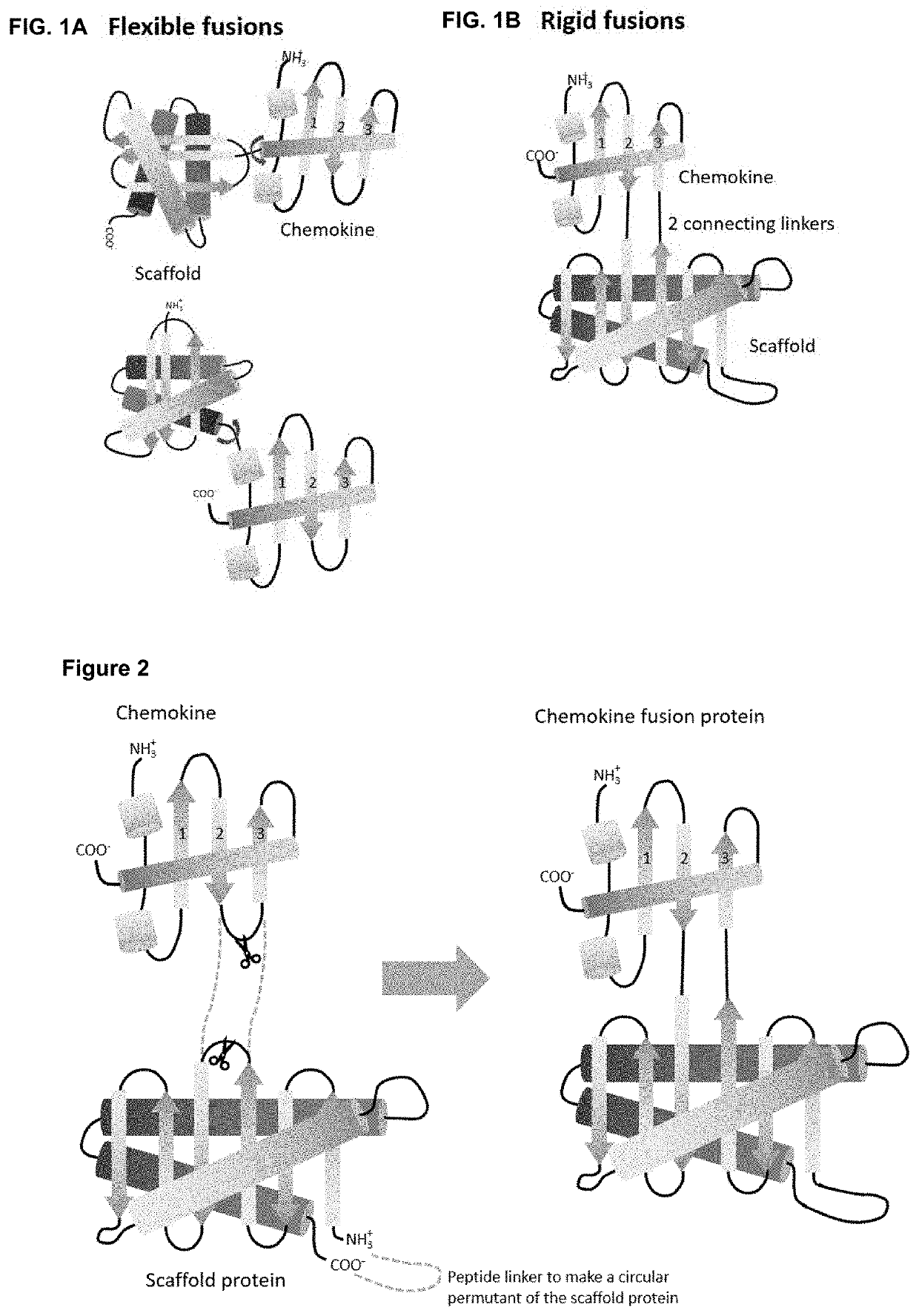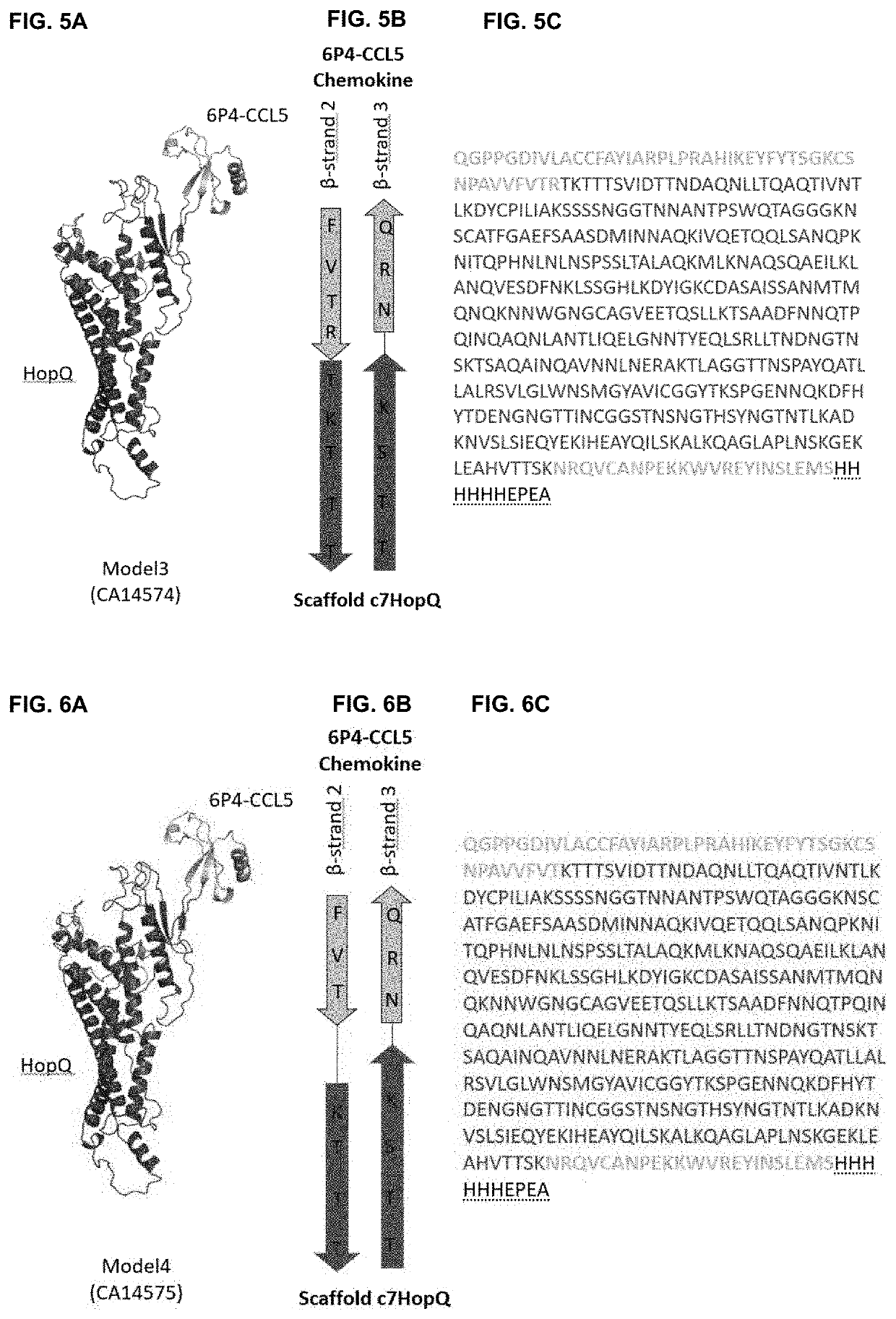Fusion proteins comprising a cytokine and scaffold protein
- Summary
- Abstract
- Description
- Claims
- Application Information
AI Technical Summary
Benefits of technology
Problems solved by technology
Method used
Image
Examples
Example
Example 1
Design and Generation of a 50 kDa Fusion Protein Built from a c7HopQ Scaffold Inserted into the β-strand β2-β3-Connecting β-turn of a 6P4-CCL5 chemokine
[0184]As a first proof of concept of obtaining rigid fusion proteins ‘Megakines’, an improved CCL5 chemokine, called 6P4-CCL5 chemokine was grafted onto a large scaffold protein via two peptide bonds that connect 6P4-CCL5 to a scaffold according to FIG. 2 to build a rigid Megakine.
[0185]The 50 kDa Megakine described here is a chimeric polypeptide concatenated from parts of chemokine and parts of a scaffold protein connected according to FIGS. 2 to 6. Here, the chemokine used is the 6P4-CCL5, derived from the natural CCL5 ligand, belonging to the subfamily of CC-chemokines, which was modified to a super agonist of CCR5 GPCR as depicted in SEQ ID NO:1 (6P4-CCL5 is an analogue of the antagonist CCL5-5P7; Zheng et al. 2017; PDB code CCL5-5P7: 5UIW). The β-turn connecting β-strand 2 and β-strand 3 of 6P4-CCL5 was interrupted for ...
Example
Example 2
Yeast Display of 50 kDa Fusion Proteins Built from a c7HopQ Scaffold Inserted into the β-strand β2-β3-connecting β-turn of a 6P4-CCL5 chemokine
[0190]To demonstrate that four Mk6P4-CCL5c7HopQV1-V4 Megakine variants (SEQ ID NO: 3-6) can be expressed as a well folded and functional protein, we displayed this protein on the surface of yeast (Boder, 1997). Proper folding of 6P4-CCL5 chemokine part was examined by using a fluorescent conjugated monoclonal antibody that binds to functional 6P4-CCL5 chemokine (Alexa Fluor® 647 anti-human RANTES (CCL5) Antibody from Biolegend, ref 515506; anti-CCL5-mAb647). In order to display the Mk6P4-CCL5c7HopQV1-V4 Megakine variants on yeast, we used standard methods to construct an open reading frames that encodes the Megakine in fusion to a number of accessory peptides and proteins (SEQ ID NO:7-10): the appS4 leader sequence that directs extracellular secretion in yeast (Rakestraw, 2009), Mk6P4-CCL5c7HopQ Megakine variant, a flexible peptide l...
Example
Example 3
Yeast Expression and Purification of 50 kDa Fusion Proteins Built from a c7HopQ Scaffold Inserted into the β-dtrand β2-β3-connecting β-turn of a 6P4-CCL5 chemokine
[0193]As we were able to display a functional Megakine on the surface of yeast, we set out to express these 50 kDa fusion proteins in the EBY100 cells as soluble secreted proteins, purified them to homogeneity and determined their properties.
[0194]In order to express four Megakines Mk6P4-CCL5c7HopQV1-V4 Megakine variants (SEQ ID NO: 3-6) we used standard methods to construct open reading frames that encode the Megakine in fusion to a number of accessory peptides and proteins (SEQ ID NO:12-15): the appS4 leader sequence that directs extracellular secretion in yeast (Rakestraw, 2009), Mk6P4-CCL5c7HopQ Megakine variant, 6× His tag, EPEA tag and STOP codon that finish the translation. This open reading frame was put under the transcriptional control of galactose-inducible GAL1 / 10 promotor into the pCTCON2 vector (Chao...
PUM
| Property | Measurement | Unit |
|---|---|---|
| Mass | aaaaa | aaaaa |
| Structure | aaaaa | aaaaa |
Abstract
Description
Claims
Application Information
 Login to View More
Login to View More - R&D
- Intellectual Property
- Life Sciences
- Materials
- Tech Scout
- Unparalleled Data Quality
- Higher Quality Content
- 60% Fewer Hallucinations
Browse by: Latest US Patents, China's latest patents, Technical Efficacy Thesaurus, Application Domain, Technology Topic, Popular Technical Reports.
© 2025 PatSnap. All rights reserved.Legal|Privacy policy|Modern Slavery Act Transparency Statement|Sitemap|About US| Contact US: help@patsnap.com



